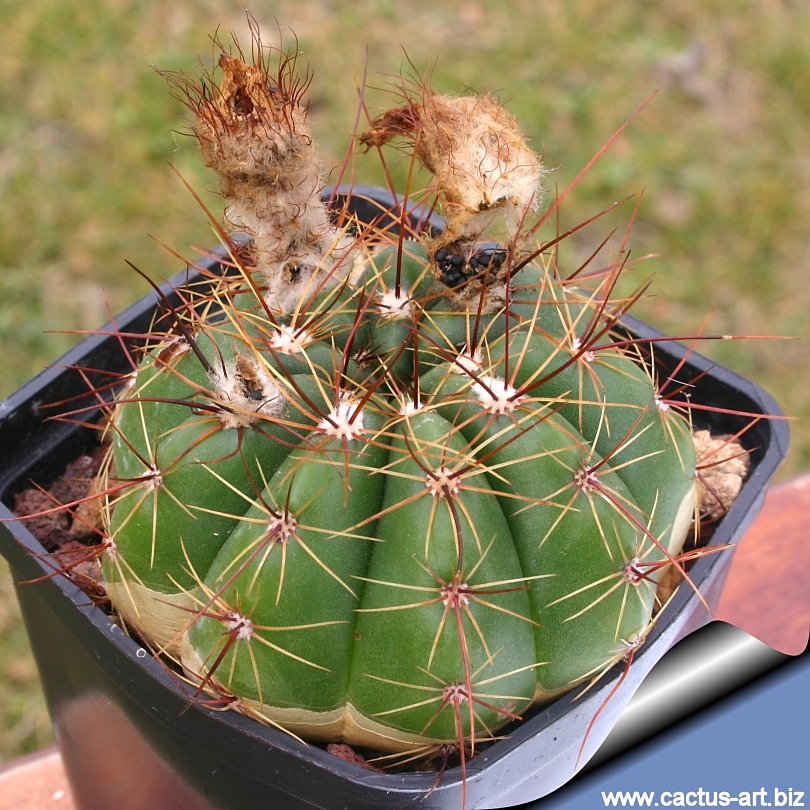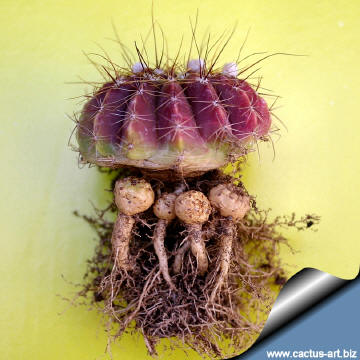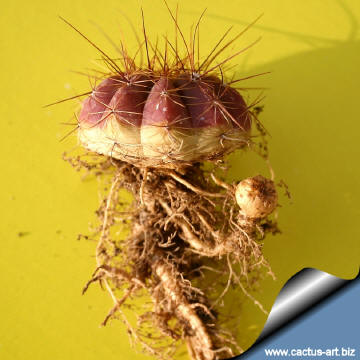|
|
|

Notocactus arechavaletai v. limiticola HU179
Sant'ana do Liveramento, Rio Grande do Sul, Brazil.
|
|
Description: Plant at first
solitary that matures and flowers at an early age. With time it form
small colonies. One of the peculiarity of this species is the tendency
to produce basal suckers on the lateral roots.
The "limiticola" is merely one of the several forms of
N. ottonis that is a common species which occurs over quite a
wide area and in consequence of that shows a great variability.
Stem: Up to 8 cm in diameter, 4 cm tall, somewhat depressed, with
white wool apically, more or less glossy green or bluish green which can
take a purple colour in under stress condition or in full sun.
Ribs: 8-9, broad and rounded, well defined.
Areoles: Few, circular up 1-2(-3) mm wide, 10-12 mm apart.
Spines: Bristly, acicular, slightly curved and spreading.
Central spines: Up to four, brownish, reddish brown or yellowish
20-40 mm long.
Radial spines: 7-9 up to 15 mm long, clearer.
Flowers: Yellow from the uppermost areoles, one or more appearing
at a time, that open only during the dayt, 5-6 cm wide, floral tube with
brownish wool and bristles. Perianth segments linear-oblong, acute,
stamens about half the length of the perianth, segments, style yellow,
stigma lobes red.
Fruit: 0,9-12 mm in diameter, ovoid to short cylindrical, thick
walled, deishent often with large number of seeds.
Seeds: Bell shaped glossy
|
 |
 |
|
Underground shoots from the roots. (The rich magenta colour of the stem is due to a
full sun exposure along with short water supply during cold winter
month, otherwise the plant is green) |
|
Advertising
|
|
|
|
|
Scientific name:
Notocactus arechavaletae var.
limiticola
Ritter
Published in:
Ritter, Kakteen in Südamerika, 1: 164, 1979
Origin: Uruguay.
Conservation status: Listed in
CITES appendix 2.
Common English Names include:
Etymology: Mud or marshes, inhabitant of, found growing near
marshes.
Synonyms:
- Parodia ottonis (Lehm.) Taylor
In: The European Garden Flora, 3: 257-265,1987, pro
parte
- Cactus ottonis Lehmann 1827
- Malocarpus ottonis (Lehmann)
Britton & Rose 1922
- Notocactus ottonis (Lehmann) A.
Berger 1929
- Echinocactus arechavaletae
Spegazzinii
In: An. Mus. Nac. Buenos Aires 3: 496. 1905
- Malocarpus arechavaletae (Spegazzinii)
A. Berger 1929
- Notocactus arechavaletae (Spegazzinii)
Herter
In: Revista Sudamer. Bot. 7: 216. as "arechavaletai"
fide Index Kewensis, Suppl. XI, 1943
- Echinocactus spegazzinii Guerke
1905 A
Conservation status:
Listed in
CITES
Appendix II
|
|
|
|

Root suckers
arise from adventitious buds
developing on the root system.
Cultivation: It
is easy to grow. It
prefers a neutral to slightly acidic
mineral-based potting mix with plenty
of extra grit and feed during the summer. It likes a warm bright location, does great in partial shade but doesn't like
full, hot blazing sun in the central summer month.
Can support quite some water during the growing season
but pot plants in winter are
wet-sensitive and
needs to be kept
dry (rots easily if soil is wet and cold) tends to lose
its roots in winter. Water Best if watered with rain water.
Usually it is recommended to
over-winter
this plant in a bright and warm greenhouse with at least 8-10° C
and rather dry (it tends to lose its
roots and to rot if the substrate is wet and cold) but
it has proved to tolerate temperatures as low as -5° C for short
periods. It
is susceptible to spider mites, so it should be check once in a while
for it.
Propagation: Seeds,
cuttings or root suckers (if available). Not too difficult to raise from seed.
ROOT SUCKERS: Root suckers are new shoots that
arise from adventitious buds developing on the lateral root system of
many plants species. They are however a quite rare kind of vegetative
reproduction strategy in cactus family, but occasionally occur in some
cactus species when roots have been injured or felled, Notocactus
arecavaletai this is one of the few specie that produces
naturally a large numbers of them and can develop into a small colony.
The suckers have the potential to develop rapidly, fed by the existing
root system. Often sprouting results in multiple stemmed plants.

 |
|